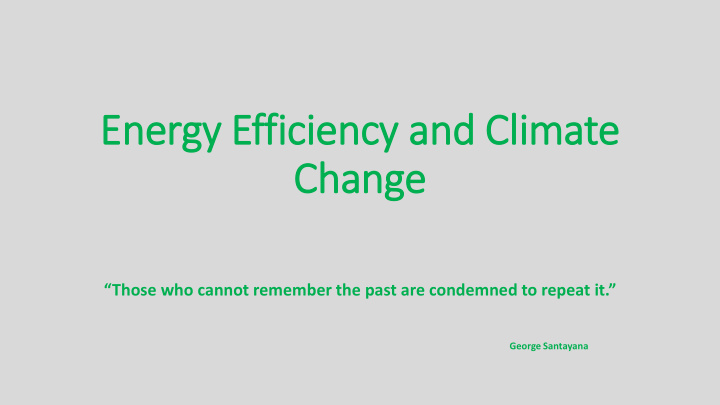



En Energy y Effici ciency an y and Cl Climate Ch Chan ange “Those who cannot remember the past are condemned to repeat it.” George Santayana
The Problem • Power generated with fossil fuels produces greenhouse gases causing climate change. The climate is warming. • People are going to be using energy for everyday tasks in the future as now, e.g. home heating, water heating, lighting, air conditioning, etc. • Technological change can be uncomfortable for many people, limiting adoption. • New technology is often more expensive in initial cost than existing mature technology.
What i is Efficiency? • % Efficiency = Output / Input * 100 ( Mathematically ) • Performing the same task using less energy.
Pre re-Industrial al R Revolution on Po Power
Draft An Animals
Wind P Power
Water P Power
Wood od F Fire f for or H Hea eat a and Li Light
Pre-Ind ndustrial al R Revolution GR GREEN Power
Timelines • Mid 1600’s large scale deforestation-coal is used as an “alternative” fuel. • Many coal mines are underground and full of water. • 1698 Thomas Savery and his steam pump (about 1 hp) • 1712 Thomas Newcomen steam engine and pump (about 5 hp) • 1765 James Watt gets a model of Newcomen’s Engine to repair at the University of Glascow. • 1769 first commercial Watt improved steam engine .
Ne Newcom omen en E Engi gine • Slow- 12 cycles per minute • Inefficient- cylinder had to be heated each stroke • Used huge amounts of coal to operate
James Watt Repairs Model Newcomen Engine
Watt’s Efficiency Improvements
Poor Initial Sales of Watt’s Improved Steam Engine • Newcomen’s engine worked- some for 50 years already. • People did not want to change. • Industrial revolution was still nascent – driven by iron and steel production, not textiles yet. • Watt hated being a salesman. • Enter Matthew Boulton!
Boulton’ n’s Pl Plan • Give the improved steam engine to the customer at no charge. (BIG Incentive!) • The customer will pay 1/3 the savings in coal in a yearly payment. • Continue to increase the efficiency of the engine with double acting pistons, rotary power, etc. • Make them available anywhere- not just for mine water pumping .
Boulton & Watt Steam Engine-Rotary Power 1782
Rotary Power 1782
Speed Regulator- Negative Feedback Device!
Ball Governor at Work
Thomas Edison’s First Electric Generator 1882
Thomas Edison’s First Electric Generator 1882
Anot other N Negative F Feedback k Device!
British £ 50 Note
Lesso essons s From T This S s Story • Many people do not like change – new light bulbs for example. • Adoption of new technologies to save energy may require incentives and education campaigns to be effective . • Efficiency can be a great selling point if people realize cost savings $$$.
The Climate Change Connection • In the future, people are going to continue to perform the same energy- related tasks they do today, such as: • Space heating • Water heating • Illumination • Cooling / air conditioning • Travel, etc.
Efficiency and Climate Change • To mitigate CO2 emissions while using fossil fuels we have to use the fuels more efficiently. • Programs such as Weatherization reduce fuel use while still maintaining comfort through building and appliance efficiencies. • A warming climate means there will be more air conditioning demand in the warm season of the year. Replacing old air conditioners is an opportunity for broad reductions in power use. • Small changes in power saving multiplied by millions of users has a great effect on power consumption and reduced greenhouse gasses. • Incentives and education work the same now as they did 230 years ago .
Thank You!
Recommend
More recommend